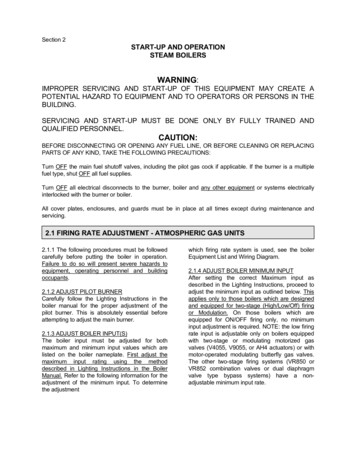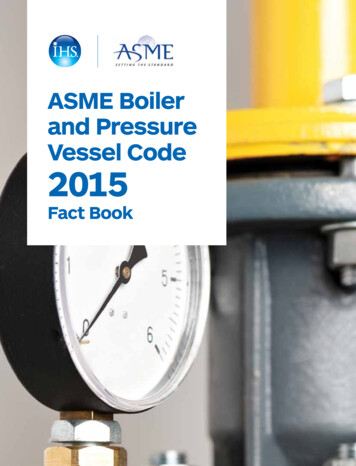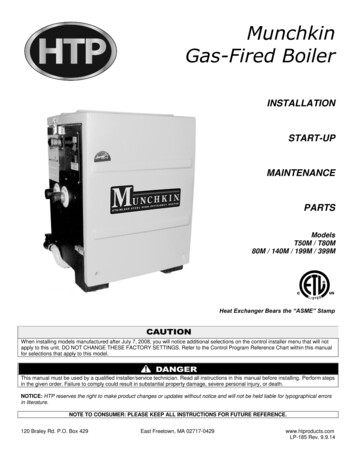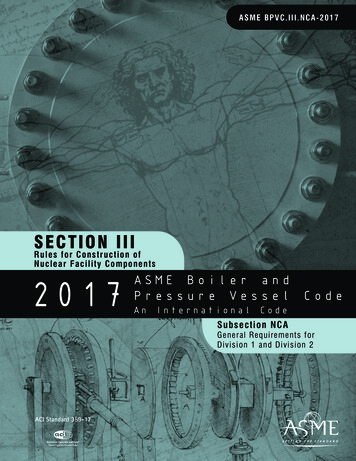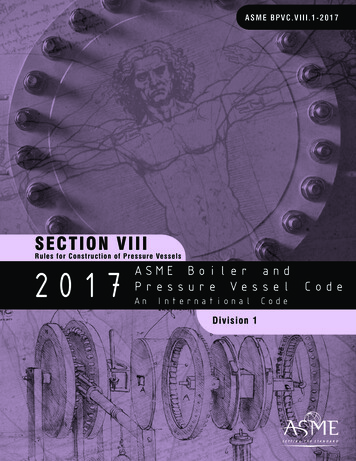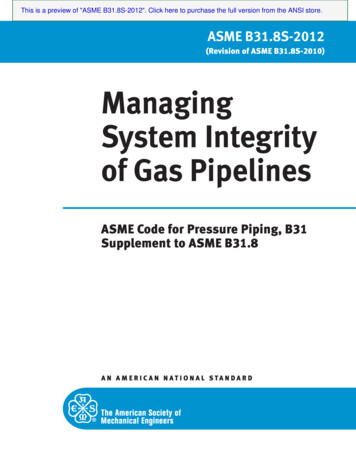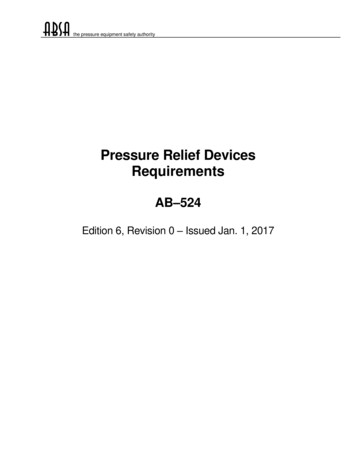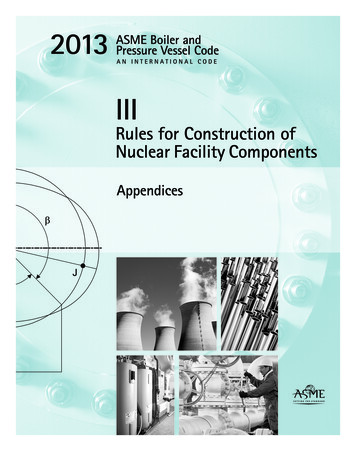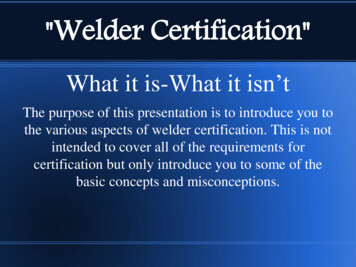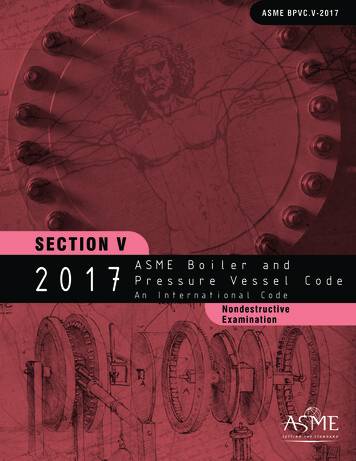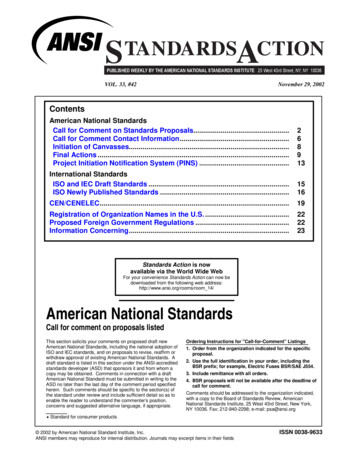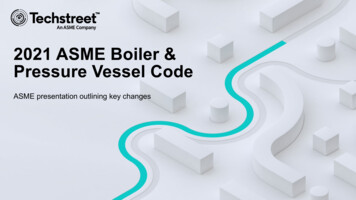
Transcription
2021 ASME Boiler &Pressure Vessel CodeASME presentation outlining key changes
Today’s Speaker and ModeratorChris MahlerASMEDirector, Derivative ProgramsConformity Assessmentmahlerc@asme.org1
ASMEASME’s codes and standards are used and developedthroughout the world by enterprises of all sizes,ranging from small- and medium-size businesses, indeveloped and developing nations, to large, multinational corporations. Manufacturers Facility owners Plant operators Designers Constructors Inspection bodies Insurers Research institutes Local and national government2124635ASME’s Worldwide Locations1. New York, NY2. Little Falls, NJ3. Washington D.C.4. Houston, TX5. Delhi, India6. Beijing ChinaEuropean Liaisons: ASME: Louis Fredericks fredericksl@asme.org ASME Conformity Assessment: Giancarlo Gobbi gobbig@asme.org
ASME Codes & Standards ASME’s Standards are produced by 4 internal development boards Below are just a few of the many standards that run across these areas:Nuclear Nuclear Codes and Standards,Sections III & XI Standards Committee on Cranes forNuclear FacilitiesSafety A17 Elevators and Escalators B20 Safety Standards for Conveyorsand Related Equipment Rail Transit Vehicle Standard CommitteePressure Technology BPVC Sections I, II, IV, V, VIII, IX, X, XII B31 Code Bioprocessing Equipment (BPE)Standardization & Testing Y14 Engineering Drawings andRelated Documents EA Industrial Energy AssessmentStandards Committee Performance Test Codes3
2021 ASME Boiler & Pressure Vessel Code Anticipated release, July 2021 ASME issued its first standard, Code for the Conduct ofTrials of Steam Boilers, in 1884 BPVC includes 29 books, plus several additional Code Case books,containing over 19,500 pages in total The standards cover industrial and residential boilers as well asnuclear facility components, transport tanks and other forms ofpressure vessels They are kept current by nearly 1,000 volunteer technical expertsfrom around the world – drawn from a balance of interests amongindustry, government and R&D – operating in a fully open &transparent manner via a consensus-driven process4
2021 ASME Boiler & Pressure Vessel Code ASME’s BPVC is a truly international set of standards: Recognized by 116 countries Helps foster international sales while mitigating trade barriers Supports manufacturers, whose products house its stamp, intheir product’s use across these many regions Allows companies, who build to the Code and use the ASMEstamp, to demonstrate their commitment to both safety & quality5
2021 ASME Boiler and Pressure Vessel Code BPVC is continuously evolving, providing essential rules & requirementsacross new materials, applications and technologies, including: Safety rules & guidelines for new construction of Nuclear andNon-Nuclear pressure devices Material properties and specifications for construction,including ferrous & nonferrous materials Customary and metric measurements Proper care and maintenance requirements for Nuclearand Non-Nuclear pressure devices Design and construction criteria across devices & components6
Non-Nuclear BPVC Sections Section I Rules for Construction of Power Boilers Section IV Rules for Construction of Heating Boilers Section VI Recommended Rules for the Care andOperation of Heating Boilers Section VII Recommended Guidelines for the Careof Power Boilers Section VIII Rules for Construction of Pressure Vessels Section X Fiber-Reinforced Plastic Pressure Vessels Section XII Rules for Construction and ContinuedService of Transport Tanks 7
Non-Nuclear BPVC Certification Section I S - Power Boilers A - Assembly of Power Boilers E - Electric Boilers M - Miniature Boiler PP - Pressure Piping V - Boiler Pressure Relief Valves PRT - Parts Fabrication Heating BoilersSection IV H - Heating Boilers/Cast IronSectional Heating Boiler HLW - Lined Potable Water Heaters HV - Heating Boiler Safety Valves PRT - Parts Fabrication Pressure Vessels8Section VIII ‒ Division 1 U - Pressure Vessels UM - Miniature Pressure Vessels UV - Pressure Vessel Pressure Relief Valves UD - Pressure Vessel Pressure Relief Devices PRT - Parts Fabrication Pressure VesselsSection VIII ‒ Division 2 U2 - Pressure Vessels (Alternative Rulesfor Pressure Vessels)Section VIII ‒ Division 3 U3 - High Pressure Vessels UV3 - HP Vessel Pressure Relief Valves UD3 - HP Vessel Pressure Relief Devices RTP - Reinforced Plastic Vessels
Non-Nuclear BPVC Certification Section X RP - Fiber-Reinforced Plastic Vessels Transports TankSection XII T - Transport Tanks TV - Transport Tanks Pressure Relief Valves TD - Transport Tanks Pressure Relief Devices PRT - Parts Fabrication9
Certification Businesses and regulators around the world rely onthe ASME Certification Mark (The Mark). ASME certification helps demonstrate to customers,supply chain, industry and regulators thatyour company is committed to public safety & quality. The ASME Single Certification Mark (The MARK) isthe international mark of safety and quality. Companies that use parts and products withThe MARK communicate their commitment to thehighest levels of public safety and quality. 10That's why businesses and regulators around theworld “Demand The Mark.”Certificate Holders0 Gray 26 – 100 Green 101 – 200 Orange 201 – 500 Yellow 501 – 1,000 Brown 1,001 – 5,000 Purple 5,001 Blue
Certification To be in compliance with Certification, the applicant must be onthe latest release of the standard 6 months after its release.All Code book purchases will be verified.ASME Information Certification BPV-GUI-03 Issue 1, Rev. 1 1205-2018 Subscription to the indicated sections of theASME Boiler and Pressure Vessel Code is required forcertification to assure that Code users have the latest applicableCode rules.ASME CA-1, 2020 Chapter 2 .2.1.3 The organization shallobtain and retain a copy of the governing standard(s) from anauthorized seller of ASME codes and standards. Reproductionsand translations from other sources are not acceptable for ASMEaccreditation and certification.11
Certification U & UM Certifications BPVC Section II ‒ Materials Part A-Ferrous MaterialsSpecifications (2 Volumes) BPVC Section II ‒ Materials Part B-Nonferrous MaterialSpecifications BPVC Section II ‒ Materials Part C-Specifications forWelding Rods Electrodes and Filler Metals BPVC Section II ‒ Materials Part D-Properties(Customary or Metric) BPVC Section V ‒ Nondestructive Examination BPVC Section VIII ‒ Rules for Construction of PressureVessels Division 1 BPVC Section IX ‒ Welding, Brazing, and FusingQualifications CA-1 Conformity Assessment Requirements12CertificationUnderstandingand MEPressTraining toExcel
Boiler Sections Section I ‒ Rules for Construction of Power Boilers Section IV ‒ Rules for Construction of Heating Boilers Section VI ‒ Recommended Rules for the Care andOperation of Heating Boilers Section VII ‒ Recommended Guidelines for the Careof Power Boilers 13
Section I ‒ Rules for Construction of Power Boilers Section I provides requirements for all methods of construction ofpower, electric and miniature boilers; high temperature waterboilers used in stationary service; and power boilers used in: Locomotive Portable Traction serviceThe rules are applicable to boilers in which steam or other vapor isgenerated at pressures exceeding 15 psig, and high temperaturewater boilers intended for operation at pressures exceeding160 psig and/or temperatures exceeding 250 Fahrenheit.14
Section IV ‒ Rules for Construction of Heating Boilers Section IV provides requirements for the design, fabrication,installation and inspection of steam heating, hot water heating,hot water supply boilers and potable water heaters, intended forlow-pressure service and that are directly fired by oil, gas,electricity, coal or other solid or liquid fuels.Section IV contains appendices that cover: Submission of new materials for approval Definitions relating to boiler design and welding Quality control systems Methods along with examples ofo Checking safety-valve and safety-relief-valve capacityo Calculation and computation15
Section VI ‒ Recommended Rules for the Care and Operation ofHeating BoilersThis Section covers general descriptions, terminology and operationguidelines applicable to steel and cast-iron boilers that are limited tothe operating ranges of Section IV Heating Boilers.Section VI includes: Guidelines for associated controls and automaticfuel burning equipment Illustrations showing typical examples of available equipment. A glossary of terms commonly associated with boilers, controlsand fuel burning equipment16
Section VII ‒ Recommended Guidelines for the Care ofPower Boilers This Section provides recommended guidelines to promote safety inthe use of power boilers. The term “power boiler”, in this Section,includes stationary, portable and traction-type boilers, but does notinclude locomotive and high-temperature-water boilers, nuclearpower-plant boilers, heating boilers, pressure vessels or marineboilers. Emphasis has been placed on industrial typeboilers because of their extensive use.Section VII includes: Guidelines to assist those directly responsible for operating,maintaining and inspecting power boilers. Operation of auxiliary equipment and appliance guidelines thataffect the safe and reliable operation of power boilers.17
Pressure Vessel Sections Section VIII ‒ Rules for Construction of Pressure Vessels Section X ‒ Fiber-Reinforced Plastic Pressure Vessels Section XII ‒ Rules for Construction and ContinuedService of Transport Tanks18
Section VIII ‒ Rules for Construction of Pressure Vessels,Division 1 Division 1 is very important from a design perspective because ofthe compulsory requirements, specific prohibitions, and impulsive,guidelines for materials, design, fabrication, inspection, and testing,markings and reports, overpressure protection, and certification ofpressure vessels having an indoor or external pressure more than15 psi (100 kPa)The Division isn’t numbered within the traditional method (Part 1,Part 2, etc.) but is structured with Subsections and Parts, whichcontains letters followed by variety.“Design-by-Rule” philosophy19
Section VIII ‒ Rules for Construction of Pressure Vessels,Division 2, Alternative Rules Division 2 provides requirements applicable to the design,fabrication, inspection, testing, and certification of pressurevessels operating at either internal or external pressuresexceeding 15 psig. This pressure may be obtained from an external source or by theapplication of heat from a direct or indirect source, or anycombination thereof. These rules provide an alternative to the minimum requirementsfor pressure vessels under Division 1 rules. These rules may alsoapply to human occupancy pressure vessels typically in thediving industry. Both “Design-by-Rule” and “Design-by-Analysis” (a methodicalapproach for demonstrating the adequacy of a pressure vesselcomponent design. It provides detailed rules for performinganalyses.) philosophy20
Section VIII ‒ Rules for Construction of Pressure Vessels,Differences Between Divisions 1 & 2 ASME Section VIII, Division 2 is intended for purpose-specificvessels with a defined fixed location. Another major differencebetween the Division 1 and Division 2 lies in failure theory.While Division 1 is based on normal stress theory, Division 2 isbased on maximum distortion energy.von Mises Distortion Energy Theory (1913). In this theory failure byyielding occurs when at any point in the body ,the distortion energyper unit volume in a state of combined stress becomes equal to thatassociated with yielding in a simple tension test.21
Section VIII ‒ Rules for Construction of Pressure Vessels,Division 3, Alternative Rules for Construction of High Pressure Vessels Provides requirements applicable to the design, fabrication,inspection, testing, and certification of pressure vesselsoperating at either internal or external pressures generallyabove 10,000 psi. Division 3 rules cover vessels intended for a specific service andinstalled in a fixed location or relocated from work site to worksite between pressurizations. Division 3 does not establish maximum pressure limits for eitherSection VIII, Divisions 1 or 2.22
Section X ‒ Fiber-Reinforced Plastic Pressure Vessels This Section provides requirements for construction of an FRPpressure vessel in conformance with a manufacturer's design report.It includes production, processing, fabrication, inspection and testingmethods required for the vessel. Section X includes three Classes ofvessel design; Class I and Class III - qualification through thedestructive test of a prototype and Class II - mandatory design rulesand acceptance testing by nondestructive methods.These vessels are not permitted to store, handle or process lethalfluids. Vessel fabrication is limited to the following processes: bagmolding, centrifugal casting and filament-winding and contact molding.23
Section XII ‒ Rules for Construction and Continued Service ofTransport Tanks This Section covers requirements for construction and continuedservice of pressure vessels for the transportation of dangerousgoods via highway, rail, air or water at pressures from full vacuum to3,000 psig and volumes greater than 120 gallons."Construction" is an all-inclusive term comprising materials, design,fabrication, examination, inspection, testing, certification, and overpressure protection."Continued service" is an all-inclusive term referring to inspection,testing, repair, alteration, and recertification of a transport tank thathas been in service.This Section contains modal appendices containing requirements forvessels used in specific transport modes and service applications.24
Nuclear Sections Section III ‒ Rules for Construction of NuclearFacility Components Section XI ‒ Rules for In-Service Inspection of Nuclear PowerPlant Components25
Nuclear BPVC CertificationSections III and XI N: Vessels, pumps, valves, piping systems, storage tanks, coresupport structures, concrete containments, and transport packaging NA: Field installation and shop assembly of all items NPT: Parts, appurtenances, welded tubular products, and pipingsubassemblies NS: Supports NV: Pressure relief valves N3: Transportation containments and storage containments OWN: Nuclear power plant owner QSC- Nuclear Material OrganizationN, NA or NPT, NS26
Section III ‒ Rules for Construction of Nuclear Facility Components Subsection NCA ‒ General requirements for Divisions 1 & 2 Appendices ‒ Mandatory and non-mandatory appendices referencedby all Divisions of Section III Division 1 ‒ Requirements for Class 1, 2, 3 and MC Components,Supports and Core Support Structureso Subsection NB ‒ Class 1 Componentso Subsection NCD ‒ Class 2 & 3 Componentso Subsection NE ‒ Class MC Componentso Subsection NF ‒ Supportso Subsection NG ‒ Core Support Structures Division 2 ‒ Code for Concrete Containments Division 3 ‒ Containment Systems & Transport Packagings Division 5 ‒ High Temperature Reactors27
Section XI ‒ Rules for In-Service Inspection of Nuclear PowerPlant ComponentsProvides requirements to maintain the nuclear power plant while inoperation and to return the plant to service following outages. Division 1 Rules for Inspection and Testing of Components ofLight-Water-Cooled Plants:Rules for the examination, inspection, and testing; NDE methods,qualifications, and requirements; evaluation and acceptancestandards for flaws, defects, and relevant conditions;repair/replacement processes and correction actions/measures inlight water-cooled nuclear power plants. Division 2 Requirements for Reliability and IntegrityManagement Programs for Nuclear Power Plants:Provides requirements for the creation of the Reliability and IntegrityManagement (RIM) Program, which addresses the entire lifecycle ofa plant for all types of nuclear power plants, including advancednuclear reactor designs.28
Service & Reference Sections Section II ‒ Materials Section V ‒ Nondestructive Examination Section IX ‒ Welding, Brazing and Fusing Qualifications Section XIII ‒ Rules for Overpressure ProtectionNEW!!29
Section II ‒ MaterialsContains four parts that efficiently organize the important materials dataused in ASME code design and construction of boilers and pressurevessels. Part A, Ferrous Material Part B, Nonferrous Material Part C, Welding Rods, Electrodes, and Filler Metals Part D, Material Properties (Customary and Metric units)30
Section V ‒ Nondestructive ExaminationContains requirements and methods for nondestructive examination thatare referenced & required by other Sections, including: Manufacturer's examination responsibilities Duties of authorized inspectors Personnel qualification requirements Inspection requirements Examination requirements31
Section IX ‒ Welding, Brazing, and Fusing QualificationsRelates to the qualification of welders, welding operators, brazers, andbrazing operators, along with the procedures they employ.Following Codes all refer to Section IX for welding and brazing : I ‒ Rules for Construction of Power Boilers II ‒ Materials III ‒ Rules for Construction of Nuclear Facility Components IV ‒ Rules for Construction of Heating Boilers VIII ‒ Rules for Construction of Pressure Vessels XI ‒ Rules for Inservice Inspection of Nuclear Power Plants XII ‒ Rules for Construction and Continued Service of Transport Tanks B31.1 ‒ Power Piping B31.3 ‒ Process Piping B31.4 ‒ Liquid Transportation Systems B31.5 ‒ Refrigeration Piping B31.8 ‒ Gas Transmission & Distribution Piping Systems B31.9 ‒ Building Services Piping B31.11 ‒ Slurry Transportation Piping Systems B31.12 ‒ Hydrogen Piping32
Section XIII ‒ Rules for Overpressure Protection Provides rules for the overpressure protection of pressurizedequipment such as boilers, pressure vessels and piping systems. Provides clear pressure integrity and performance requirements,enabling users to identify a pressure relief device’s performancealong with anything needed to support overpressure protection. Organizes all requirements by pressure relief device type, includingany exceptions or unique ones identified in a specific BPVC section,enabling users to easily identify all requirements across a device. Places capacity certification requirements across BPVC’s manysections into one centralized location for easy reference, allowingusers to easily compare the test results of different equipmentacross similar applications.33
Errata Errata to codes and standards may be posted on the ASME Website under the Committee Pages to provide corrections toincorrectly published items, or to correct typographical orgrammatical errors in code and standard. Such errata shallbe used on the date posted. On the Committee Page, there is an option available toautomatically receive an e-mail notification when errata areposted to a particular code or standard.34
Boiler & Pressure Vessel Code Code Cases Created when an urgent need arises for alternativerules concerning materials, construction, or an inservice inspection activity not covered by existingBPVC rules. Released 7 times over the 2-year BPVC edition cycle Provided as part of a subscription service forpurchasers of BPV or Nuclear Code Case books Available for download until a supplement is issued,after which, the PDF is removedInterpretations Written replies to inquiries concerning interpretation oftechnical aspects of the Code Issued throughout the year, as they are approved Posted for free to the interpretations database No longer included as a part of the BPVC publication35
Resources BPVC/Certification 36
Now PresentingSteven J. RossiASMEProject Engineering ManagerStandards & Certificationrossisj@asme.org37
2021 BPV Code Major Changes This presentation is a general summary of some of the majorchanges that will appear in the 2021 Edition of the ASME Boiler &Pressure Vessel Code. All changes to the Code will be available when the 2021 Edition isissued in July, 2021. The specific detailed changes should be carefully reviewed andverified as published in the 2021 Edition to ensure compliance withCode requirements.38
General Change to Sections I, IV,VIII (Divisions 1, 2, and 3), X, and XII Adopted the new ASME BPVC Section XIII, Rules forOverpressure Protection Revisions to Sections I, IV, VIII (Divisions 1, 2 and 3),X and XII have been issued concurrent with thepublication of Section XIII. These include the transferof pressure relief device requirements, from each ofthe aforementioned Sections to Section XIII. 39The remaining overpressure protection requirementshave been restructured; cross-references updated;and new Appendices added to list the new locationsfor all those requirements, formerly located in each ofthe Sections.INSERT PICTUREHEE
Section I ‒ Rules for Construction of Power Boilers Revised Figure PG-33.2 sketch (c) to depict d as the OD of thenozzle, in addition to reinstating Figure PW-16.1(Z) sketches as anew sketch (j). Revised Figures PG-58.2-1 and PG-58.2-6 by deleting the flowarrow for miscellaneous piping connections, in addition to replacing“Chemical Feed” and “Drum Sampling” references with “WaterTreatment”. Revised PG-58.3.1 to further clarify the limits of BEP for a singleinstallation. Revised PW-39.1 to add reference to Table PW-39.2, addressingtemperature ranges for dissimilar and similar weld joints.40INSERT PICTUREHERE
Section II ‒ Materials The range of acceptable ASTM editions has been updated for anumber of specifications. The Guideline on the Approval of New Materials Under the ASMEBoiler and Pressure Vessel Code has been updated.INSERT PICTUREHERE41
Section II ‒ Materials, Part A, Ferrous Material Specifications Updates to the latest adopted edition have been madeto over 15 specifications. Two new specifications have been added:o SA-988/SA-988Mo SA-989/SA-989M 42One specification has been removed, SA/NFA 36-215.INSERT PICTUREHERE
Section II ‒ Materials, Part B, Nonferrous Material Specifications Updates to the latest adopted edition have been made to over45 specifications. Two new specifications have been added:o SB-752/SB-752Mo SB-834 43One specification has been removed, SB-858.INSERT PICTUREHERE
Section II ‒ Materials, Part C, Specifications for Welding Rods,Electrodes, and Filler Metals 44Six AWS specifications for arc welding electrodes, gas welding rods andother filler metals adopted or updated into the 2021 edition & one removed:oAWS A5.01M/A5.01:2019 "Welding and Brazing Consumables Procurement of Filler Materials and Fluxes" as SFA-5.01M/SFA-5.01oAWS A5.17/A5.17M:2019 "Specification for Carbon Steel Electrodes andFluxes for Submerged Arc Welding" as SFA-5.17/SFA-5.17MoAWS A5.26/A5.26M:2020 "Specification for Carbon and Low-Alloy SteelElectrodes for Electrogas Welding" as SFA-5.26/SFA-5.26MoAWS A5.28/A5.28M:2020 "Specification for Low-Alloy Steel Electrodesand Rods for Gas Shielded Arc Welding" as SFA-5.28/SFA-5.28MoAWS A5.34/A5.34M:2018 "Specification for Nickel-Alloy Flux Cored andMetal Cored Welding Electrodes" as SFA-5.34/SFA-5.34MoAWS A5.39/A5.39M:2020 "Specification for Flux and ElectrodeCombinations for Submerged Arc and Electroslag Joining and Surfacingof Stainless Steel and Nickel Alloys" as SFA-5.39/SFA-5.39MoRemoved SFA-5.36/SFA-5.36M, since AWS and ANSI have withdrawnA5.36/A5.36M.INSERT PICTUREHERE
Section II ‒ Materials, Part D, Properties (Customary, Metric) Existing stress lines for Grade 91 have been designated as “Type1” and new lines have been added for Grade 91 “Type 2” withhigher allowable stresses. Tables 6A through 6D containing allowable stresses for ASMEBPVC Section IV have been made mandatory. Incorporated Code Cases 2445-2, 2543, and 2603-1. Additions and revisions to stress tables and mechanical propertytables have been made to support updated specifications.45INSERT PICTUREHERE
Section III ‒ Rules for Construction of Nuclear Facility Components,Subsection NCA, General Requirements for Division 1 and Division 2 NCA-1111 revised to include the scope of Division 5 and to providea reference to Subsection HA to direct the user to generalrequirements for high temperature reactors. NCA-3461, NCA-3561, NCA-3661, NCA-3684 and NCA-3785revised to provide consistency and clarification regarding N typeCertificate Holders responsibilities. 46NCA-3862.2 revised to add requirements for N-type certificationof materials.INSERT PICTUREHERE
Section III ‒ Rules for Construction of Nuclear Facility Components,Subsection NB, Class 1 Components NB-3324 revised to add an additional thickness formulafor nonspherical heads in Class 1 construction. NB-3500 revised to define requirements for safety relief devices.INSERT PICTUREHERE47
Section III ‒ Rules for Construction of Nuclear Facility Components,Subsection NCD, Class 2 and Class 3 Components Subsections NC and ND consolidated into one Subsection NCD.The new Subsection NCD contains the requirements for both Class2 and Class 3 components. NCD-3531.1 and NCD-3593.1 revised to add design andtest requirements to address Pilot Operated Relief Valves (PORVs)and Pressure Actuated Relief Valves (PARVs). Table NCD-4622.7(b)-1 revised to add rows for socket welds for PNo. 3, P-No. 9A Gr. 1, and P-No. 9B Gr. 1. General note: The rest of Section III was editorially revised to nowrefer to NCD rather than the individual subsections.48INSERT PICTUREHERE
Section III ‒ Rules for Construction of Nuclear Facility Components,Subsection NE, Class MC Components Figure NE-2575.2-1 revised to add General Note C to clarify thatthe sketch shown is typical but is to be used as guide for minimumrequired coverage of other configurations. Deleted NE-3228.1(a). NE-4211 revised to align NB/NC/ND/WB/WC/WD-4211. NE-6111 revised to clarify that “non-welded access openingcovers” are exempted from pressure testing.49INSERT PICTUREHERE
Section III ‒ Rules for Construction of Nuclear Facility Components,Subsection NF, Supports Various revisions made to Subsection NF and Appendix F to reflectappropriate stress limit conditions identified in the NRC RegulatoryGuide 1.130. NF-3322 revised to be consistent with AISC 360-16 and to alignwith current industry guidance for pin-connected members. Two new figures added to provide clarity in application of thedimensional limitations described in the text. NF-3223.5 added to provide additional specificity as to how todetermine the critical buckling stress of NF Plate and Shelldesigns.50INSERT PICTUREHERE
Section III ‒ Rules for Construction of Nuclear Facility Components,Subsection NG, Core Support Structures NG-3211 revised to provide requirements to address buckling ofbeams and columns. The terms related to stress analysis in NG-3213 updated to beconsistent with those in Mandatory Appendix XIII, Design Based onStress Analysis. Deleted NG-3228.1(a) since the limitation on analytical methods for"the remaining stress limits" is no longer needed. NG-3225, NG-3228, NG-3235 revised to consolidate and clarifythe rules for limit analysis within Subsection NG.51INSERT PICTUREHERE
Section III ‒ Rules for Construction of Nuclear Facility Components,Appendices XIII-3430 revised to add a new criterion to explicitly address theratchet limit due to thermal membrane stress in addition tocombined thermal membrane plus bending stress range. Appendix XXVI updated to add new Nonmandatory Supplement Eto provide guidance for the pressure design of PE and metallic-toPE flanged joints. Nonmandatory Appendix B revised to add guidance for additionalultrasonic examination for high alloy metals. New Nonmandatory Appendix MM added to provide guidance onthe stress linearization process, based on the stress linearizationguidelines in Section VIII, Division 2.52INSERT PICTUREHERE
Section III ‒ Rules for Construction of Nuclear Facility Components,Division 2, Code for Concrete Containments Revised to harmonize the material sizing system. All metric barand coupler sizes referenced within the Code have been revised tomaintain the US material sizing system. Revised CC-2438.4.1 and CC-2438.4.2 to clarify that qualificationtest data and test data for permanent corrosion protection materialas defined in CC-2438 shall be certified. Table CC-2623.2-1 revised to update strength requirements for studs. CC-2710 and CC-3121 revised to provide clarification on existingrequirements.53INSERT PICTUREHERE
Section III ‒ Rules for Construction of Nuclear Facility Components,Division 3, Containment Systems for Transportation and Storage ofSpent Nuclear Fuel and High-Level Radioactive Material Subsections WB, WC and WD revised to clarify the prohibition ofcertain welding processes. Section WC-2129 added to include requirements forfabricated hubbed flanges. Section WC-3263 added to include requirements for Category CWeld Joints for Flat Heads with Hubs. Various Figures and paragraphs revised in WB-3000 to clarify therequirements for the hypothetical fire event.54INSERT PICTUREHERE
Section III ‒ Rules for Construction of Nuclear Facility Components,Division 5, High Temperature Reactors HHA-3217 revised to update the failure probability calculationto increase the accuracy for fine grained graphite materials. Figure HBB-T-1420-1E revised to update the series of fatiguecurves for Grade 91 at elevated temperatures from 700F to 1200F. Appendix HBB-T revised to provide equations for the isochronousstress-strain curves.55INSERT PICTUREHERE
Section IV ‒ Rules for Construction of Heating Boilers Revised the design temperature of plain furnaces in HG-312.1(b). Added requirements to allow for alternative marking of small partsbased on BPV Section I, para. PG-106.8.2. Removed the allowable stress tables from Section IV and updatedthe refe
BPVC Section V ‒ Nondestructive Examination BPVC Section VIII ‒ Rules for Construction ofPressure Vessels Division 1 BPVC Section IX ‒ Welding, Brazing, andFusing . ASME Section VIII, Division 2 is intended for purpose-specific vessels with a defined fixed location. Another major difference
